
|
|
# 33. The Great Dictator (1940) Charlie Chaplin's first talking picture contains one of filmdom's most splendid pantomime sequences. At the time of Hitler's rise to power, Chaplin played both an unnamed Jewish barber and the dictator of Tomainia, Adenoid Hynkel. As Herr Hynkel, uniformed in his Hitler-like outfit in his imperial palace office, he performs an "emperor of the world" ballet/dance with a giant, balloon-like globe of the world which he hopes to dominate. He approaches the globe, holds his hands out delicately to surround it, and imagines himself possessing and caring for it. Hynkel removes the globe from its stand and raises it aloft - he spins and balances it with one hand, while letting go with a sick, maniacal laugh. He sends it sailing into the air over his head - it floats from one hand to the other and back. As it drifts down, he gives it a light rear kick with his heel and it soars toward the high ceiling in the room. When it descends, he bounces it upwards with his head - his hands are interlaced in front of his waistline. When it floats down again, he lets it bounce and then adoringly catches it in his outstretched arm. He sizes it up for a moment, and then repeats the kicking action and the head-bounce. After a few more gentle tosses as he moves toward his desk, he catches the globe. While reclining on his back on the top of his desk, he swiftly kicks it into the air. When it descends a second time, he twists slightly and projects it upwards with two gentle bounces off his fanny. He catches it once more, spins it, and stares lovingly at it. After more tosses, he leaps onto the top of his desk, sends it aloft, jumps to the floor in front of the desk, and grabs it on the way down. As he holds out the conquered world, it suddenly explodes in front of his face - he holds up the tattered rubber rag - all that is left of his world. Distressed, he whirls away, puts his head on his desk, and with his back to the camera, he bursts into tears. |
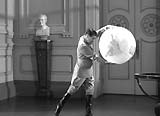 
|
|
# 34. Citizen Kane (1941) This is the most-honored film in all of film history, with many sequences or images worthy of a mention. One of its greatest sequences is at the end of the film, when the secret of the word "Rosebud," the last word uttered by Charles Foster Kane (Orson Welles) before he died, is finally revealed. The camera pulls away from the basement floor to show the incredible accumulation of Kane's acquisitions over a lifetime. Then, the camera slowly glides over years and years of his pitiless pieces of material goods and collected art objects, looking like a broken jigsaw puzzle, a deserted skyscraper city, or a metropolis when photographed from high above. There in the piles of possessions are:
Kane's life appears as a disjointed collection of failed energy to productively use resources. In the basement beneath Xanadu, workers clear away the vast array of junk and articles. A workman is sorting and crating his possessions near an incinerator, a blazing furnace where items are thrown that are considered junk. The worker with the sled in his hands is told by Raymond, the butler, to "throw that junk" into the flames of the incinerator to be consumed, along with an accumulation of other possessions. The sled, the one that young Charles played with when he was with his father and mother early in the film, is an enduring and beautiful symbol of Kane's life. The name "Rosebud" (and its decorative flower) is briefly seen on the sled in a close-up before flames lick the wood, the heat warps and blisters the paint of the wooden surface, and it is consumed by the flames. The "Rosebud" sled is a momento from Kane's childhood with his mother, a childhood that was interrupted by the opportunities wealth and fortune bestowed upon him. He rammed Thatcher (George Coulouris) with the sled when he was forcibly taken away to New York to be raised in more affluent surroundings. The sled symbolized the innocence, beauty, and love that he lost, the love that eluded him - a dying man's memory of a childhood possession that held special meaning. |
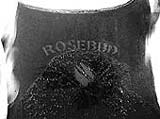 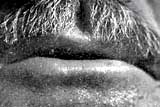
|
|
# 35. The Lady Eve (1941) Preston Sturges' sophisticated romantic comedy is a battle of the sexes highlighting the painful, antagonistic terrors of sexual passion and seduction. The sexual comedy is the story of a sophisticated, card-sharp, Eve-like temptress who takes advantage of an innocent, vulnerable, snake-loving man - a literal Garden of Eden fable. Charles Pike (Henry Fonda), a snake-expert is the obvious next target of calculating cardsharks and con artists Jean (Eugenia) Harrington (Barbara Stanwyck) - appropriately nibbling on an apple - and her father "Handsome" "Colonel" Harry (Charles Coburn) Harrington. The memorable scene of his seduction in Colonel Harrington's cabin is one of the most satirically sexy scenes ever filmed. As they enter the cabin, the naively-innocent adventurer remarks on the overpowering presence of her perfume - he's "been up the Amazon for a year" where "they don't use perfume." Wearing a black, exposed-midriff outfit, Jean invites him, her Prince Charming, to pick out a pair of evening "slippers' for her to wear. She points to a compartmented shoe bag with fifty pairs of shoes, seducing him with suggestive lines as she leans back on the trunk flirtatiously: "The shoes are over here. Because you were so polite you can pick them out, and put them on, if you like..." After he has shyly chosen an appropriate pair of evening slippers, she sits down and crosses her nyloned leg in front of him - revealing her evening gown slit to her knees. She elegantly dominates him, suggesting that he put the slippers on her feet. He clumsily gets on one knee in front of her, with his face almost touching her kneecap. Charles' vision blurs as he reels dizzyingly in front of her and takes ahold of her foot. While holding onto her leg and fiddling with her shoe strap, he distracts himself from her allure by explaining how he is a snake-enthusiast and a beer heir nicknamed Hopsie. As he finishes putting on her 'slippers,' he finally admits how he is smitten with her and bursting with desire from the powerful aphrodisiac of her perfume. He attempts to make a pass at her: "You see, where I've been, I mean up the Amazon, you kind of forget how, I mean, I haven't seen a girl in a long time, I mean, there's something about that perfume..." He leans forward to kiss her, but she holds him back: "Why Hopsie, you ought to be kept in a cage!" |
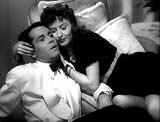
|
|
# 36. The Maltese Falcon (1941) At the conclusion of John Huston's seminal film noir, tough detective Sam Spade (Humphrey Bogart) utters the definitive byline for all Hollywood films. As the mysterious and duplicitous Brigid O'Shaughnessy (Mary Astor) is led away to the hallway's elevator by a detective, Spade asks: "Well, shall we be getting down to the hall?" Police Sergeant Tom Polhaus (Ward Bond) delivers one of the film's final lines when he lifts up the heavy black statuette as they are leaving the room: "It's heavy. What is it?" Spade responds while touching the bird:
The detective makes a puzzled response: "Huh?" Spade takes the statuette from Polhaus' hands and walks to the stairs. In a memorable parting close-up, Brigid is tearfully being taken away, waiting in the elevator for the gates to close. The steel cage is pulled in front of her like the bars on a cell, framing her frightened, motionless, lonely face in the bars of the gate. The outer door shuts and the elevator drops from view - she disappears down the elevator shaft to her fate. Spade takes the stairs with Polhaus. The case is closed. [Another unforgettable sequence is the one in which Gutman (Sydney Greenstreet) feverishly unwraps the newspaper-shrouded bird, gazes upon it, and then anxiously scrapes and chips at its surface with his penknife - wildly realizing that the bird is a fake.] |
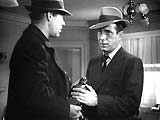 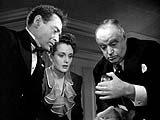
|
# 37a. Casablanca (1942) The finale of one of the most beloved films ever made (by Michael Curtiz) is justly celebrated. The romantic drama ends in the dense airport mist and fog, after American cafe proprietor Rick Blaine (Humphrey Bogart) says goodbye to the only woman he has ever loved, the luminous Ilsa Lund (Ingrid Bergman) with her Resistance leader husband Victor Laszlo (Paul Henreid). For Rick, no sacrifice is too great - he touches her cheek with one finger after delivering one of the film's most famous speeches:
He also kills the sinister German Nazi/Gestapo commander Major Heinrich Strasser (Conrad Veidt) who is trying to apprehend them. The crafty Chief (Prefect) of police Captain Louis Renault (Claude Rains) is sympathetic toward Rick and ultimately lets him off the hook by commanding his men: "Round up the usual suspects." |
 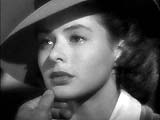
|
|
# 37b. Casablanca (1942) Then, in the fog, they watch the plane leave the ground for neutral Lisbon. Renault offers Rick a way out of Casablanca - the cafe owner is willing to accept the transit letter, but not in exchange for cancelling their wager. Rick walks off with Captain Renault across the wet runway, as they discuss what they might do together with the 10,000 francs [$300], the payment due on their earlier bet over whether or not Laszlo would ever get out of Casablanca. The closing in the fog brings another great classic line [dubbed in later] as Rick tells Renault that they have forged a new alliance as they head off for an uncertain future together: "Louis, I think this is the beginning of a beautiful friendship." Their new partnership is underscored with the sounds of La Marseillaise, earlier sung in a classic scene in the cafe (and led by Laszlo) as a statement of solidarity against the Germans. |
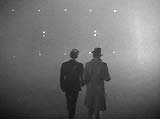 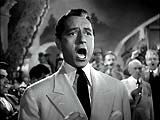
|
|
# 38. Now, Voyager (1942) The famous cigarette trick occurs in a tale of love between Charlotte Vale (Bette Davis), a middle-aged, withdrawn spinster from a wealthy Boston family who is transformed from an ugly duckling into a beautiful, self-assured woman, and a handsome, unhappily-married, suave European named Jerry Durrance (Paul Henreid). During a South American cruise, Charlotte discovers life and love when she meets him and they fall in love and have an affair. In their famous scenes, cigarette smoking becomes a sensual act. In the final scene of the film, he asks Charlotte once more: "Shall we just have a cigarette on it?" She responds breathlessly: "Yes, sir," holding out an opened cigarette box. He takes two cigarettes and puts them in his mouth, lights them both, and then hands one over to Charlotte. The film ends with Charlotte's most memorable line on the balcony. Although she knows Jerry will never leave his wife, they have found something far more enduring and happy:
As the music swells, the camera moves between them and ascends above the trees to a starry night sky. |

|
|
# 39. Saboteur (1942) The agonizing, breath-taking, harrowing death sequence in Alfred Hitchcock's thriller is a terrifying, suspenseful bit of film-making. After a cross-country chase, suspected saboteur Barry Kane (Robert Cummings) has confronted the real fifth columnist Frank Fry (Norman Lloyd) on the top of the Statue of Liberty - on its torch held high above the water of New York harbor. Windblown against a cloudy sky, Fry loses his balance and falls over the side of the railing - he bounces once and is left clinging to the space between the immense base of the thumb and the forefinger that compose the concrete hand of the statue. Kane climbs down to rescue the spy - he half-crouches and has one hand wrapped around part of the base of the torch. With his free hand, he can only reach and clutch Fry's coat jacket sleeve near the wrist. As Fry perilously hangs there clinging for his life and perspiration beads appear on his forehead, the sleeve begins to tear apart at the seam where the arm joins the shoulder. The saboteur literally dangles by a thread. As the split widens, Fry's terror-stricken face notices that his entire coat jacket will soon separate. He cries out: "Quick, the sleeve, the sleeve!" And then his arm slips suddenly out of the sleeve - in a disorienting, downward view from Kane's perspective, Fry falls away through space and drops to his death many feet below. His face contorts, his body rotates awkwardly, and his screams become fainter as he approaches the ground. |
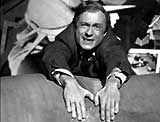
|
|
# 40. Yankee Doodle Dandy (1942) The spirited, spunky and domineering acting performance of James Cagney as song and dance man George M. Cohan in this biopic is unbelievably rousing. Especially in the title number, George, as horse jockey Johnny Jones - the Yankee Doodle Boy himself, stands on a pedestal next to a race horse, and is soon surrounded by long-gowned, glittering dancers/singers. He sings the film's classic, all-time favorite title song: "Yankee Doodle Dandy":
As the chorus is sung, the limber song and dance hoofer George struts back and forth across the stage with a stiff-legged gait, bent forward with a straight upper torso. His high, straight-toed kicks, jerky convolutions (like a unwieldy marionette), a bit of bouncing, twirling, tap-dancing, and other assorted, arrogant movements make the dynamic, vigorous dance number come alive. The side walls of the immense stage become part of his dance floor as he walks up them to make his turns. |
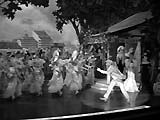 |
|
# 41. The More the Merrier (1943) In George Stevens' part screwball comedy, part romantic comedy, wartime Washington housing shortages force the prim, working bachelor girl Connie Milligan (Jean Arthur) to rent out some of her apartment space. An elderly, match-making gentleman Benjamin Dingle (Charles Coburn), a "retired, well-to-do millionaire" in Washington for business, rents out half of her apartment, and then sub-lets his half to clean-cut young aviation expert Army Sergeant Joe Carter (Joel McCrea), in Washington on special duty. One balmy evening, Joe accompanies room-mate Connie home - she is provocatively dressed in an off-the-shoulder black lace evening dress, with a string of white pearls around her soft neck, and her hair is decorated with a white flower. On the way she turns a streetcorner and nearly walks into one of many kissing couples on the sidewalk. As they talk about his family, he keeps taking off and putting on her wrap, putting his hand on her bare shoulder, and taking her arm in his. When she asks about his girlfriends, they almost kiss in a shot framed between two small tree trunks, but then she resists and pulls away and asks: "Are you afraid to get married or something?" As he embraces her, they collapse on the front steps of their shared apartment. In their famous courtship scene on the front steps, she speaks about her plans for her own marriage and her future with her fiance, an older man, forty-two year old ("a safe and sane age") government official - her stuffed-shirt boss, Charles J. Pendergast (Richard Gaines): "I consider myself a very lucky little lady...being engaged to Mr. Pendergast." All the while, he is amorously embracing her, caressing her, and fondly touching her hands, arms, and shoulders - she vainly attempts to ignore his advances. She holds out her engagement ring for his approval and he responds by kissing her wrist. Connie becomes visibly distracted and her voice cracks when he admires and then nuzzles her bare neck. "Well you see, that's the way with those older men like Mr. Pendergast. A girl gets to appreciate their more mature..." He passionately kisses her on the lips - when he releases, she finishes the sentence: "...viewpoint." She pauses, looks away for a second, and then takes the two sides of his face with her hands and boldly kisses him back - harder. But then, she realizes that they are getting too involved - she stands and politely states: "I've gotta go. Good night, Mr. Carter." He responds: "Good night, Miss Milligan." She ascends the stairs into the building and shuts the door. He begins walking away and then sheepishly remembers that he is leaving his own apartment: "I almost forgot where I lived." Connie holds the door open for him. As they bed down in adjacent rooms - shot from outside in a frame split by the wall between them, they discuss how uncomfortable and restless they are, and Joe finally admits: "I love you, Connie" and she responds likewise: "I love you more than anything in the world." |
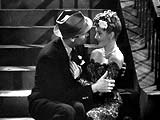 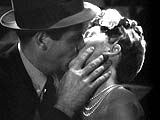
|
|
# 42. To Have and Have Not (1944) The startling movie debut of 19 year-old Lauren Bacall was in Howard Hawks' loose adaptation of the Hemingway novel. She held her own as Marie Browning, a self-reliant, tough, insolent, no-nonsense romantic partner to boat Captain/privateer Harry Morgan (Humphrey Bogart). Morgan first meets the young, sultry, and stranded American in the doorway of his room in the hotel/nightclub's upstairs hallway. She has appeared from her rented room across the hall from his. In her first husky, sexy lines to him as she leans in the door, she makes a simple, deadpan request for a match, but it sounds like an erotic challenge: "Anybody got a match?" He tosses her a box of matches and she aggressively lights the flame, looking at him with her wide expressive eyes. She flings the used match backward out the door, tosses the box of matches back at him, and turns and leaves without any emotion: "Thanks." Later, at the beginning of one of the screen's most famous seductions, Slim sits on his lap. Before kissing the seated man for the first time, she acts the aggressor role as they engage in flirtatious sexual repartee. Her verdict of his kissing talent requires a second kiss. Then, after kissing him again, he appears baffled. She suggests to her passive partner as she stands: "It's even better when you help." When this remark doesn't immediately work and produce a satisfactory reaction, she propositions him midway from leaving his room with other famous lines, delivered with a calculated coolness: "You know, you don't have to act with me, Steve. You don't have to say anything and you don't have to do anything. Not a thing. Oh, maybe just whistle. (She opens his door and pauses.) You know how to whistle, don't you, Steve? You just put your lips together - and blow." He continues to remain seated in his chair, smoking a cigarette. After she has left, he makes the sound of a cat-call whistle - and then chuckles to himself. |
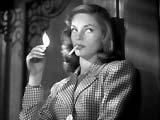  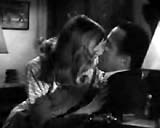   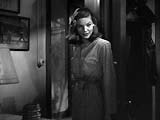
|
1950s (1) | 1950s (2) | 1960s | 1970s-1990s |
|